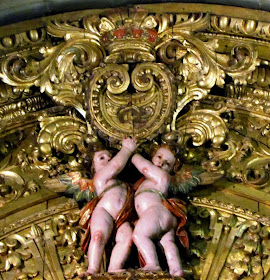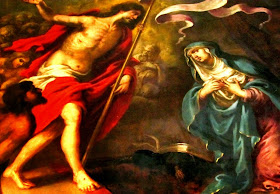A PATROL OF ROM PICKPOCKETS (NEXT 2 PICTURES)
LARGO DA TRINDADE
RUA NOVA DA TRINDADE
CERVEJARIA DA TRINDADE
Rua Nova da Trindade 20C - Chiado
Tel: 00 351 21 3 423 506 |
( THE BUILDING )
( Igreja de São Roque )
N 38.7131303 ; W 9.14331
The Igreja de São Roque (Church of Saint Roch) in Lisbon was the earliest Jesuit church in the Portuguese world, and one of the first Jesuit churches anywhere. It served as the Society’s home church in Portugal for over 200 years, before the Jesuits were expelled from that country. After the 1755 Lisbon Earthquake, the church and its ancillary residence were given to the Santa Casa da Misericórdia de Lisboa (the Charity House of Lisbon) to replace their church and headquarters which had been destroyed. It remains a part of the Santa Casa today, one of its many heritage buildings.
The Igreja de São Roque was one of the few buildings in Lisbon to survive the Earthquake relatively unscathed. When built in the 16th century it was the first Jesuit church designed in the “auditorium-church” style specifically for preaching. It contains a number of chapels, most in the Baroque style of the early 17th century. The most notable chapel is the 18th-century Chapel of St. John the Baptist (Capela de São João Baptista), a project by Nicola Salvi and Luigi Vanvitelli constructed in Rome of many precious stones and disassembled, shipped and reconstructed in São Roque; at the time it was reportedly the most expensive chapel in Europe.
N 38.7131303 ; W 9.14331
The Igreja de São Roque (Church of Saint Roch) in Lisbon was the earliest Jesuit church in the Portuguese world, and one of the first Jesuit churches anywhere. It served as the Society’s home church in Portugal for over 200 years, before the Jesuits were expelled from that country. After the 1755 Lisbon Earthquake, the church and its ancillary residence were given to the Santa Casa da Misericórdia de Lisboa (the Charity House of Lisbon) to replace their church and headquarters which had been destroyed. It remains a part of the Santa Casa today, one of its many heritage buildings.
The Igreja de São Roque was one of the few buildings in Lisbon to survive the Earthquake relatively unscathed. When built in the 16th century it was the first Jesuit church designed in the “auditorium-church” style specifically for preaching. It contains a number of chapels, most in the Baroque style of the early 17th century. The most notable chapel is the 18th-century Chapel of St. John the Baptist (Capela de São João Baptista), a project by Nicola Salvi and Luigi Vanvitelli constructed in Rome of many precious stones and disassembled, shipped and reconstructed in São Roque; at the time it was reportedly the most expensive chapel in Europe.
.JPG)
.JPG)
-D.JPG)
-F.JPG)
.JPG)
-A.JPG)
-B.JPG)
-C.jpg)
-D.JPG)
-E.JPG)
-I.JPG)
-J.jpg)
-L.JPG)
-M.JPG)
-R.JPG)
-U.JPG)
-V.JPG)
-W.JPG)
-X.JPG)
-N.JPG)
-O.JPG)
-P.JPG)
-C.JPG)
-B.jpg)
-D.jpg)
-E.jpg)
-F.JPG)
-J.JPG)
-K.JPG)
-L.JPG)


-M.JPG)
-N.JPG)
-O.JPG)
-P.jpg)
-V.JPG)
-W.JPG)
-A.JPG)
-B.jpg)
-D.JPG)
-G.JPG)
-J.JPG)
-M.JPG)
-N.JPG)
-A.JPG)
-B.JPG)
-C.jpg)
-E.JPG)
-F.JPG)
-D.JPG)
-E.JPG)
-G.jpg)
.JPG)
-A.jpg)
-B.jpg)
-C.JPG)
-D.JPG)
-E.JPG)
-F.JPG)
-G.JPG)
-H.JPG)
-I.JPG)
-J.JPG)
-K.JPG)
-M.JPG)
-N.JPG)
-O.JPG)
-P.JPG)
-Q.JPG)
-R.JPG)
-S.JPG)
-C.JPG)
-D.JPG)
-E.JPG)
-F.JPG)
-G.JPG)
-H.JPG)
-I.JPG)
-J.jpg)
-K.jpg)
-L.jpg)
-A.JPG)
-E.JPG)
-F.JPG)
-H.jpg)
-J.JPG)
-k.jpeg)
-L.jpg)
-N.JPG)
-P.JPG)
-R.JPG)
-T.JPG)
-V.JPG)
-B.jpg)
-C.JPG)
-D.JPG)
-E.jpg)
-G.jpg)
-J.JPG)
-L.JPG)
-A.JPG)
-B.JPG)
-C.JPG)
-A.JPG)
.jpg)
.jpg)









































































































































































.jpg)
.jpg)
.JPG)
